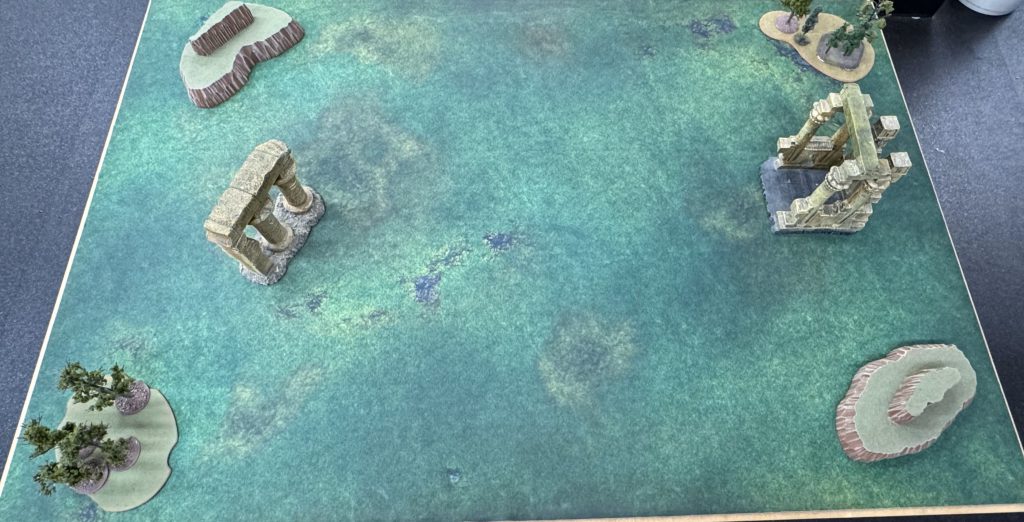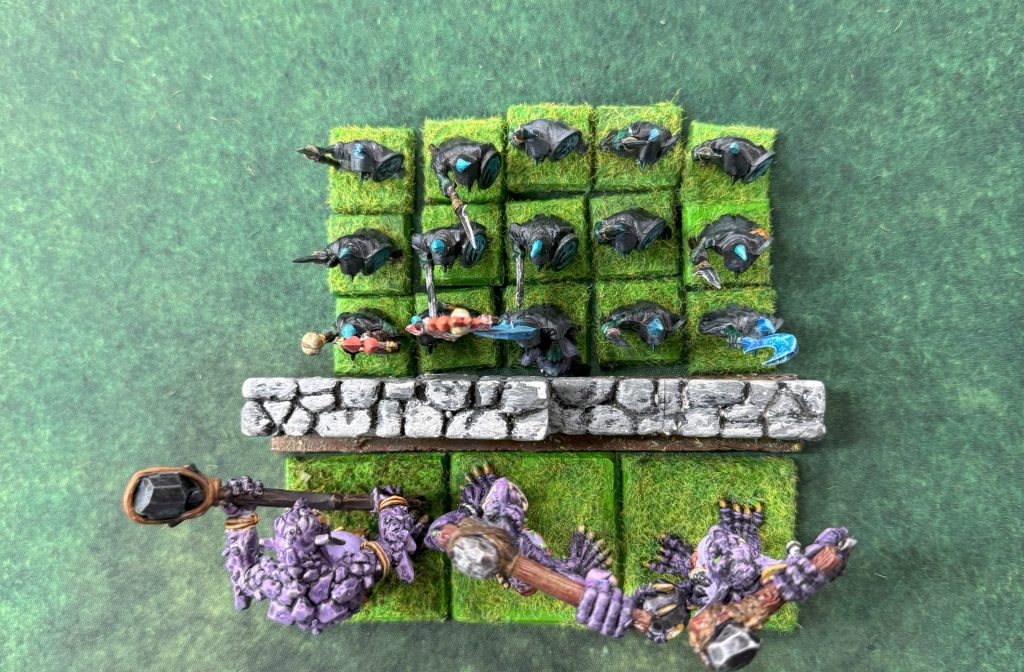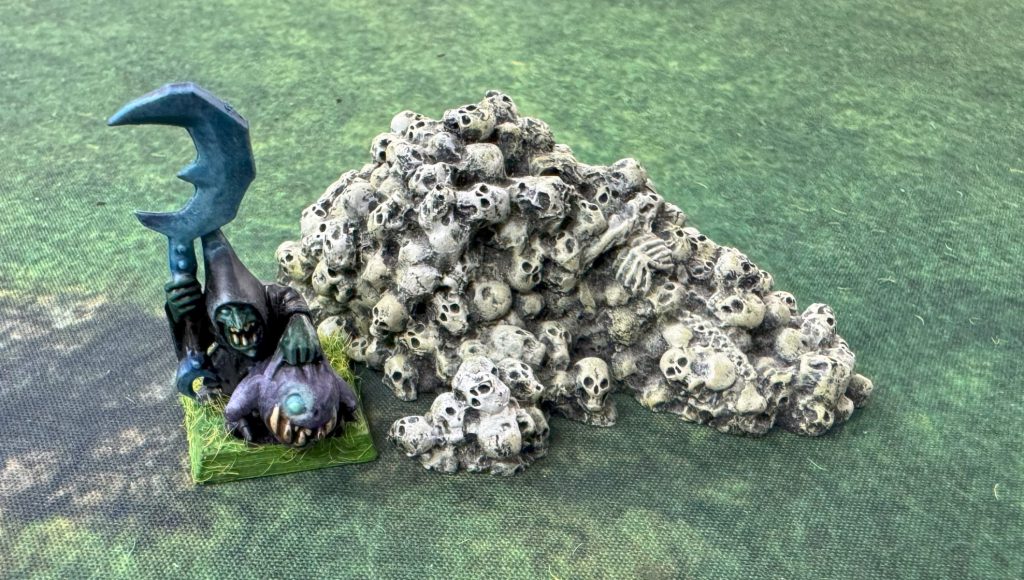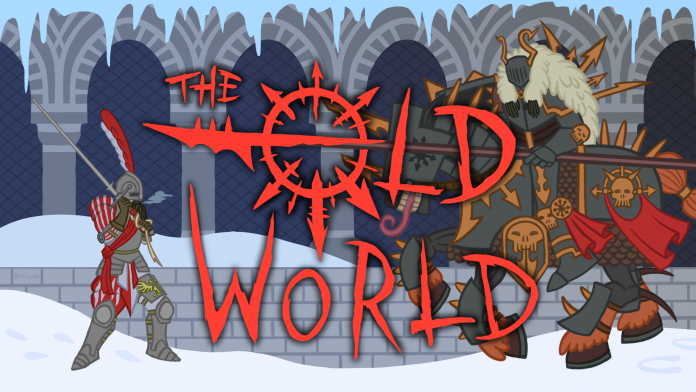Good day my fellow wargamers! We will be taking a dive into the terrain rules provided for us in the Warhammer: The Old World Rulebook and discussing each type, as well as some ideas on how to use them on the table. Hope you all enjoy this journey through the fantastical landscape of the Old World.
What Is Terrain?
Terrain is a catch-all term to describe the objects and areas of the play area that are used to generate an interactive landscape for the players and their armies. The Warhammer: The Old World Rulebook (WOWR) defines the terrain rules on pages 268 through 275. There are some other areas in the rulebook that also reference terrain depending on the rule or interaction in question. We will cover those as they come up.
Terrain is what you make of it. Some people start out using books, candles, and cardboard; some make their own; others buy breathtaking professional prices that are artwork in and of themselves. Regardless of the materials, the key is how you use and why. Without further ado, it’s time to buckle up as we journey through the many landscapes of the Old World together!
Terrain Types
The WOWR defines multiples types of terrain and even goes as far as to open the door and encourage special custom terrain to help forge the narrative. We will explore them in order as presented in the rulebook.
Open Ground: Oddly enough the rulebook uses a somewhat circular definition for this terrain type. Simply put, open ground is an area of the battlefield that is not any other defined terrain type. It is any part of the table where the terrain has no other defined rules or interactions with the game.

Difficult Terrain: The WOWR defines Difficult terrain as “any rough ground that might cause those attempting to cross it to struggle” (WOWR Page 269). A key component of Difficult terrain is that it can be applied to just about any other terrain type (except open ground of course). Many other terrain types are also counted as Difficult terrain. The way Difficult terrain interacts with the game is as follows:
- As soon as any model makes contact with Difficult terrain it suffers a -1 to its movement characteristic. Keep that in mind! It only affects the movement characteristic itself, not any other such as pursuits, and flees. This creates some wonky circumstances. So lets take a second to clarify some questionable situations:
- Charges: Since charges involve a model’s movement characteristic when a charge is successful or as part of a pursuit of a fleeing enemy, this would reduce the overall distance by 1”.
- Random Movement: Rules-as-written, random movement does not explicitly state whether or not the dice roll counts as the model’s “movement characteristic.” In fact it states that the dice roll is the “distance the model must move” (WOWR Page 176). Having said that, later on at the end of the random movement rule it states that models have “random movement characteristics.” I believe this means the implicit ruling is that the dice roll is the movement characteristic and is therefore impacted by the -1 caused by Difficult ground.
- Caveat: This is subject to debate and interpretation, and has been hotly contested on the internet, so discuss it with your TO and local group first.
- Fly: Fly models break a lot of rules by using the power of defying gravity. Fly explains that models move the distance in inches shown in the fly bracket (x). This has a similar issue to random movement and is not explicitly called a movement characteristic. I believe the rest of the fly text shows the implicit by stating “Models move as normal;…as if they were moving on the ground” (WOWR page 170). Lucky for us, Games Workshop provided a clarification in the FAQ which clarifies fly is “essentially a second movement characteristic” (Official Warhammer the Old World FAQ & Errata – Version 1.2)
- Fly has the following exceptions to moving when it comes to terrain:
-
-
-
-
- Models with fly may move over terrain without penalty.
- Models with fly that end their move in terrain suffer the terrain’s effects (because they land at the end of their movement).
- Nowhere does it say what happens if they begin their movement in terrain so technically rules-as-written you only suffer penalties if you end your movement. This is not intuitive. Welcome to The Old World, nerd.
-
-
-
- Charges: When a unit charges through Difficult terrain it makes its roll as normal but discards the highest of the 2D6 rather than the lowest. This only impacts the initial 2D6 rolled and does not impact additional dice from other effects like swiftstride.
- Example: Calvary Model charges a unit and has to move through difficult terrain. It rolls its initial 2D6 generating a 3 and a 4. The 4 is discarded and then the unit rolls its swiftstride dice as normal.
- This effect has similarities to how it interacts with other movement rules in the game like difficult terrain -1 to movement. Fly Models still are only impacted if their charge move would end in Difficult terrain.
- The key difference is this effect happens prior to actually entering the terrain. This happens even if the unit never actually makes it into contact with terrain due to the low dice effect or -1 to movement.
Let’s look at some examples of this in action. In the pictures below, the trolls roll up a charge. Because of the Difficult terrain they would choose the lowest die and that would be their charge roll moving 8″. This would normally be a successful charge, but due to the -1″ penalty it would actually fail. Because the charge would fail, the trolls only move forward the charge roll of 2″.
In the second example below we see some trolls chasing some fleeing goblins! The trolls would normally catch the goblins since the low die was a 5 and the goblins are only 11″ away but due to the -1″ penalty they stop 1″ away from the goblins.
- Disruption: Units that end their movement or the combat phase with 25% or more of their models inside the Difficult terrain become disrupted and do not gain rank bonuses. (Watch out for models with warband!) See below for examples of what a disrupted unit looks like.
Dangerous Terrain: The best way to think of Dangerous terrain is like “violent” Difficult terrain. Essentially, all Dangerous terrain is Difficult terrain, but not all Difficult terrain is Dangerous terrain. In addition to the effects of Difficult terrain above, a model that begins, ends, or passes through Dangerous terrain using its movement must take a Dangerous Terrain Test. What is a Dangerous Terrain Test?
- Each model rolls a d6; on a 1 the model loses a single wound. This means the wound bypasses saves.
In addition, while in combat, models treat Dangerous terrain as Difficult for determining disruption. All other caveats apply, including Fly getting to ignore the terrain unless they end their movement on it.
Impassable Terrain: Quite simply, Impassable terrain is terrain that cannot be moved onto or over.
- This can cause some wonky situations, from forcing disordered charges to preventing skirmishers from forming up.
- Any unit that cannot fully align to a unit at the end of a charge during the charge move counts as having made a disordered charge.
- Impassable terrain can block line of sight but it does not innately do so. It is up to the players to determine any additional traits this terrain piece has.
Example 1: General Charges. In the examples below, the trolls are trying to charge some goblins who cunningly take position behind Impassible terrain. The trolls in the first two photos cannot charge successfully since they cannot wheel around the Impassible terrain and still make contact. But in the second two photos, the trolls have a better position and can make contact with the goblins.
Example 2: Flying Charges. Models with fly tend to break the rules like we see above and can ignore the Impassible as long as they have a landing spot and can make contact. Remember though: Even models with fly need line of sight to declare charges!
Example 3: Disordered Charge. In the example below, the angles result in a situation where there is still a gap between the giant and the goblins. This means the giant would suffer from a disordered charge. (I think he won’t mind.)
Linear Obstacles: These are sections of terrain that most people would identify as walls, ditches, or even bushes. The only measurement given for obstacles has to do with their height to classify them:
- Low Linear Obstacle: These are obstacles that are 2” or less in height. They can be moved over top of. These have unique properties listed below:
- Low linear obstacles are considered difficult terrain
- Units “straddling” (a weird way to say standing on top of) a low linear obstacle are disrupted and cannot claim a rank bonus.
- In the example below the trolls charge but are forced to land “on top” of the wall to complete the charge. You can resolve it by actually placing the trolls on the wall, or by just using some markers to represent the position of the trolls instead.
- Low linear obstacles are considered difficult terrain
-
- Any Unit can choose to “defend” a low linear obstacle by moving into base contact with it. The rulebook defines the interaction further:
- “Enemies can charge the defenders as normal but do not have to physically cross the obstacle. Instead, the front rank of a charging unit moves into base contact with the opposite side of the obstacle. Unless it has the Fly (X) special rule, a unit that charges an enemy behind a defended low linear obstacle makes a disordered charge.” (WOWR Page 271)
- Any Unit can choose to “defend” a low linear obstacle by moving into base contact with it. The rulebook defines the interaction further:

- High Linear Obstacle: These are obstacles that are more than 2” high. These are simply treated as Impassable terrain.
- Oddball Effects: Technically a low linear obstacle can be of infinite width. There is no specific rule as to the length and width dimensions. Only the height and the players’ own opinions decide if it’s a low linear obstacle. By the letter of the rule you could have a 10” by 10” low linear obstacle to create really silly situations.
Woods: Ah, the favorite terrain of certain naturally-flavored elves. Woods (or Forests as many call them) are a very popular terrain type in fantasy. They have the following unique rules:
- Footprint: Woods must have a “footprint”. That is a clearly defined boundary to the terrain piece. Trees and shrubbery in the woods terrain piece have zero functional impact on the actual game state; they are just scattered pieces to make the terrain look like a forest. It is actually encouraged in the rules to push your shrubbery aside if it has a hindered movement.
- Multitype: Woods can be Difficult, Dangerous, or Impassible. It just depends on the piece and what the players want.
- A Covering of Shrubbery: Any model or unit counts as being behind partial cover as long as half or more of the model or unit is within the clearly defined edge of the terrain feature.
- Arboreal Gloom: “If a wood lies between two models and if neither model is within the wood, a line of sight can only be drawn between them if an uninterrupted line can be drawn between their bases without crossing over or through the wood.” (WOWR Page 271)
Line of Sight Examples for Woods:
Hills: Hills are sloped/raised pieces of terrain that provide elevation to add a third dimension to gameplay. These pieces offer multiple interactions to a tabletop:
- High Ground (Page 153): If your unit is “higher” in position than the enemy than you get the high ground bonus. This is…subjective as hills are not clearly defined as “sloping”. Instead by written rules, hills are more like elevated plateaus with sheer drops. See below for some examples of how this might look in a real game:
- Vantage Point (Page 272): This provides two primary benefits:
- Fire in Extra Ranks: Units on top of a hill can fire with one additional rank.
- This part of the rule does not use the word “entirely” like the second part does, and if you want to be a sweatlord you could argue that all you need is one model in a unit touching the hill to gain this benefit.
- Line of Sight: Units entirely (that is wholly on top of the hills footprint/area/boundary) can see over any units or models not on the hill. This is a little tricky but essentially if your base is entirely on the hill (or all the models in a unit are wholly on the feature) you can see over any model or unit that is not touching the hill at all. Many people get this wrong in the games I play but the restrictions are very clear.
- This also means that the models on a hill can be seen regardless of any intervening models or units. Terrain will still obscure line of sight as normal.
- Fire in Extra Ranks: Units on top of a hill can fire with one additional rank.
- Beyond the Crest (Page 272): “If a hill lies between two models and if neither model is upon the hill, a line of sight can only be drawn between them if an uninterrupted line can be drawn between their bases without crossing over or through the hill.” (WOWR)
Battlefield Decorations: These are decorative only terrain pieces. Usually they are small rocks, brush, skulls, or other easily removable objects that help fill a table’s empty spaces and give it a more immersive feel. These objects have no impact on the models and interactions on the table other than to increase the visual appeal.

Combined Terrain Types: Since this is a game where gamers tell stories and enjoy their time with the overall experience the rulebook encourages players to develop their own unique terrain. This can be for a more competitive experience, a narrative flare, or simply because its cool. You could make a hill that’s also a forest, and has a linear obstacle. These types are mostly for fun and you simply combine all of the effects at once to these pieces to get their table effects.

Special Features: In addition to the generic terrain types, the rulebook gives “templates” for special terrain features. This includes magical terrain, towers, ruins, and other unique elements to a fantasy battlefield experience. The rulebook also encourages the players to make their own unique pieces. There is one particular rule I would like to touch on though as we close out this overview that is unique to the special terrain section:
- Occupation: Some terrain types allow models/units of certain unit types to “hop inside.” They do this by moving into base contact with the feature, and then are “placed inside.” While the rulebook in all its wisdom and wonder does not define what this means, I would assume you place the unit to the side, on top of, or off the table and mark that the building is occupied in some way to streamline gameplay. While Occupying a terrain feature, units:
-
-
- Cannot charge.
- Can shoot (and cast spells) and is considered to have a 360° vision arc from the special feature itself.
- Can be shot at (and be targeted by spells) by a unit (or Wizard) that can draw a line of sight to the special feature. However, the unit is considered to be behind full cover.
- All measurements to or from a unit that occupies a special feature are made to or from the base of the feature, rather than the individual model(s).
-
- Additional Occupation rules:
- Special features do not tend to be particularly large. Therefore, they can only be occupied by a single unit.
- Unless it is fleeing, a unit occupying a special feature can leave it during the Remaining Moves sub-phase of its Movement phase, by making a follow up move, or by pursuing an enemy. Simply place the unit information, so that at least one model is in base contact with the feature. The unit’s movement then ends.
- There are more rules unique to certain terrain types like towers and ruins. These can all be found on pages 273-276 of the WOWR.
Now that we have covered the overview of all the types of terrain available in The Old World lets move on to some more crunchy conversations about using it in game.
Why It Matters
I used to be the kid that played with a bright green grass mat (you old people know the one) and textbooks, cans, cheap plastic toy walls, and whatever else we could find. I never really appreciated good terrain until I got older and started watching online battle reports where they set up some truly breathtaking and immersive tables. I like to split the “reason” for having good terrain into two main camps: Immersion and Gameplay
Immersion: Good and-well made terrain makes or breaks many people’s gaming experience. Many of us spend hours on our armies to paint them, base them, and array them on a glorious battlefield and it often means we lack the time to invest in equally stunning or engaging terrain pieces. Good terrain helps create a narrative, and narratives help create engagement. That engagement is what brings many people to this world of Warhammer. When the heroic knights charge down the hill into the undead horde, or the vile dragon charges over the scattered defenses to break the lines it gives each player a visual connection to anchor a truly wonderful imaginative experience.
I think this is why having a local gaming store with decent to amazing terrain is vital to many communities. No one really wants to play on 2D mousepad battlefields or grey concrete boxscapes. We want to play on lush jungles, destroyed villages, or desert landscapes.
Luckily, 3D printing and more affordable terrain has really helped make this an accessible option. Thanks to my printers I have created two terrain sets, one jungle themed and one dwarven hold/ruins themed. Both provide an interesting narrative backdrop to battles and both were surprisingly cheap on finances and time to produce. (Maybe I’ll write another guide to making terrain…) If you are looking for a more immersive experience, first talk to your LGS and if that isn’t an option, take a look at some of the cheaper terrain sets online, or consider making your own! It will change the gaming experience greatly!
Gameplay: The other major important factor for terrain is how it influences the game itself. Does that hill provide a benefit that impacts the battle itself? Does that ruin force me to make different choices when deploying and engaging my opponents army? The impact terrain has on the table itself are wonderful elements to spice up the standard rank and flank combat system we know and love. Good terrain placement and selection are what make or break many experiences. It is here that I think that players have the most diversity of opinion. Many players prefer open “classic” battlefields. Others prefer “mirrored” battlefields for better balance. Some people (like me) love dense centralized terrain that forces a lot of hard choices and impacts the game significantly. Regardless of your approach the goal should ultimately be to create a fun and memorable experience with your opponent. Remember folks…we are playing with toy soldiers!
Table Layouts
I would be remiss if I did not include some sample layouts of battlefields. While I won’t break each layout down in detail I will provide a brief overview of the general philosophy and a photo gallery of the examples of that philosophy to help give some context to what most The Old World tables look like these days.
Forge the Narrative Layout: These are maps that prioritize the story. They strive to create visual masterpieces that enhance the gaming experience, develop the narrative, and facilitate the theme, tone, and pace of a developing conflict. The primary goal of these layouts is to tell your story about your dudes and create a cinematic memory for you and the other players involved. (Photos credited to Derger.)
The Competitive Mirror: The most common competitive layouts use a “balanced” approach to table creation. In an attempt to not give any one side a significant advantage they strive to create a table state that is equal in its terrain proliferation and type for both players. I do not personally agree with the “Mirror” philosophy in table set up but I do understand why its a staple in tournament formats.
The Casual Experience: The WOWR sets rules for player placed terrain. It recommends using 6 features of terrain on the average 6X4 table/play area. These rules are actually quite good for on the go gaming. Each player takes it in turns to place one piece of terrain anywhere on the battlefield. The only restrictions being terrain cannot be within 12” of other terrain or the middle of the battlefield. The exception to the 12” rule is special terrain features that need to be placed in the center of the battlefield. The rules also encourage using battlefield decorations and scatter terrain to spice up the table if it needs to be more visually appealing.
Have any questions or feedback? Drop us a note in the comments below or email us at contact@goonhammer.com. Want articles like this linked in your inbox every Monday morning? Sign up for our newsletter. And don’t forget that you can support us on Patreon for backer rewards like early video content, Administratum access, an ad-free experience on our website and more.






































